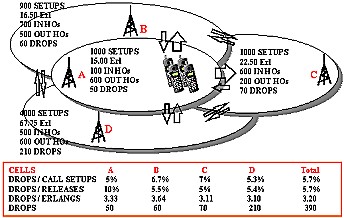
3G VIEWS AND OPINIONS
Mobile Network Quality
Network Performance: Are you chasing the right target?
By Petri Possi
Most of the 2G operators did not get the network performance optimised. Some did not have the knowledge, money, tools or the vendor support. Some operators were not important enough for the vendor to help the network quality process. Some operators concentrated too much on technical details and forgot the big picture, the customers and the operator's revenue flows. Some operators simply decided not to put effort to it or decided that with a dropped call operator gets another call and acquires more revenues from the customer. Some were chasing the wrong target without knowing it. No wonder churn rate is around 30 percent around the world.
RF Planning department's antenna configuration changes and parameter modifications (often incorrectly called as "network optimising") are only a part of the network performance optimising process. When deciding how to optimise the network performance, operators need to take couple of steps back, consider how the network should perform (and what are the real performance targets) from the business point of view and then to have a hard look at the work processes. Once all goals of the network optimisation are set, more detailed performance criteria can be considered. Operators should then understand and define the importance of each type of quality problem. For example: How many call setup failures equals one call drop or one handover failure and why? And also who is responsible of each part of the process. For example: Who is responsible of troubleshooting trivial Phone, BSC or BTS hardware problems?
Several 2G network vendors created famous BTS fault lists, which calculate the priority of which BTSs needed to be investigated. Lists were typically different weighted sums of a collection of system problem indicators based on vendor's opinions and available measurements. Top BTSs on the list were usually sites with multiple time-consuming site design problems that were difficult to solve in as reasonable time. Engineers quickly learned to avoid the top sites and priority lists were not working as intended. Special nomination for the most confusing performance measure goes to call drops per tch channel seizures formula that several vendors were pushing in mid 1990's, hopefully nobody is using that any more.
 To illustrate the point that it is not easy to prioritise the network improvements with limited resources and time, here is a fundamental network performance problem. The problem looks trivial at first, but is worth a deeper consideration. There are four sectors serving an area. Each of them has different traffic amount, call drop rates and call drops per Erlang figures. To really understand what network performance optimisation is, the solution to this basic dilemma needs to be understood. And this type of situations occurs all the time in the network. To illustrate the point that it is not easy to prioritise the network improvements with limited resources and time, here is a fundamental network performance problem. The problem looks trivial at first, but is worth a deeper consideration. There are four sectors serving an area. Each of them has different traffic amount, call drop rates and call drops per Erlang figures. To really understand what network performance optimisation is, the solution to this basic dilemma needs to be understood. And this type of situations occurs all the time in the network.
See the full size picture. (60k)
The question is: Which one of these four sectors should be troubleshooted first?
And, of course, Why? How will follow later.
You can post your cell selection and comments to the message board (message board is closed now).
3G Operators have a good opportunity to start performance optimisation fresh, but I hope the operators' management does not fall in to the "every quality problem is a top priority" trap. More about 3G network quality later...
Added comments four weeks later:
This article did not inspire much discussion (message board is closed now), so I will come back to network quality issues later. If you are interested to discuss about network performance, send me an email.
- Petri Possi is an independent wireless network consultant. He has over ten years experience in a wireless industry working with network planning companies, infrastructure vendors and mobile operators. You can send him feedback through info@umtsworld.com
DISCLAIMER: The content of the column represents the views, opinions and judgments of the writers and do not necessary reflect the views of UMTSWorld.com. Each contributor holds the copyright to his or her articles. UMTSWorld.com only publishes articles with their permission.
|